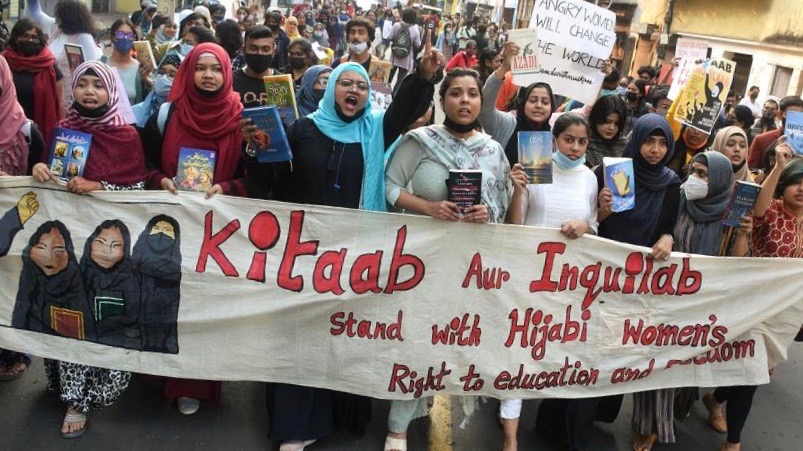The verdict by a court in the Indian State of Karnataka in mid-March against the wearing of headscarves or the Hijab across colleges, preventing Muslim girls from entering educational premises with a certain dress code, has created a political furor in the country.
Since the verdict was announced on March 15, several protest actions have been carried out such as a complete strike in the State of Karnataka on March 17.
For many women activists the verdict is seen as a major disappointment and betrayal by the judicial system. Many fear that the “headscarf ban” will only add to the growing hostility against the minority Muslim community and further the selective targeting of Muslim women in online hate campaigns.
Teenager Aliya Assadi was among the students who filed the petition challenging the decision of the Karnataka government to prescribe a uniform in educational institutions. The petition had argued that the decision goes against the right to education and the right to practice one’s faith as guaranteed in the Indian constitution.
The affected girl students had placed their hope in the judiciary and the constitution, but it was a “case of betrayal for us,” Aliya told reporters.
“I was made to realize I am a Muslim… I had read on social media the discrimination that Muslims in the country face but now I have experienced it for the first time,” 19-year-old student Al-Rifa said after she was barred from entering the Bhandarkar’s college in Karnataka wearing a headscarf.
Similarly, many other students who have been wearing the headscarf as part of their “religious obligation” have now been asked to remove them if they want to attend lectures. “The administration isn’t allowing us inside the classes if we don’t remove the hijab, personally for me it is weird. We were first optimistic that the court would favor our pleas. Unfortunately, the political pressure created in the country by different forces is so high even the courts are favoring the majority without realizing the complications it will have for us,” 16-year-old Sana told local media.
The Hijab row
In January, a major controversy erupted in the Udupi district of Karnataka when a government-run college stopped six teenage girls wearing headscarves from attending classes claiming that it violated school uniform guidelines.
The restriction invoked protests in the campus by the students which spread to other educational institutions. The hijab-wearing students demonstrated for days outside the gates of the college. While the administration later allowed them inside the campus, they were made to sit in separate classrooms with no lectures organized for them.
Amid the rising tensions, a number of Hindu far-right groups rallied in support of the restrictions imposed on Muslim women saying that if the administration permits Hijabs inside schools, Hindu students should also be allowed to wear saffron shawls (a color used by Hindu nationalists).
Some of the protests in campuses and in some other States were disrupted by the police which triggered stone pelting incidents and tear gas shelling on the crowds.
The controversy became so intense that the Karnataka State authorities had to shut down schools and colleges for three days and restrict gatherings near educational institutions for two weeks.
Online hate campaigns
The ban on wearing the Hijab is being viewed as a coercive way to force Muslim women to renounce their religious practices and adhere to the majoritarian identity which is slowly becoming synonymous with the Hindu identity.
According to Tayyaba Ahmad, a geography student at Jawaharlal Nehru University in New Delhi, the communal ‘Jai Shri Ram’ chants by Hindutva supporters during the Hijab row inside campuses in Karnataka reinforced the narrative that right-wing Hindu nationalists want the minorities cornered and submissive and accept the religious hegemony in the country.
Several commentators have called the Hijab controversy a political gimmick by far-right Hindu nationalist groups to spread propaganda under the pretext of fighting extremism, turning the agency of Muslim women as a cannon fodder for a certain political agenda.
“There is no concept of respecting the agency of the women, they aren’t given this choice by far-right Hindu groups who continue to exploit the victimization of Muslim women in order to amplify their narrative of Hindutva which excludes minorities,” Tayyaba told Peoples Dispatch.
There has been a pattern of online hate campaigns filled with communal slurs and misogynist bullying from radical Hindu right-wing groups targeting Muslims women in India. One example is the fake online app Bulli Bai, a derogatory Hindi term used by right-wing misogynists to describe Muslim women in the country.
The fake auction app listed around 100 women for ‘sale’, including journalists, actors, artists, activists and several other noted figures. Most of the women targeted through the app have been outspoken critics of prime minister Narendra Modi and his government. Prior to this app, another auction list insulting Muslim women appeared in July 2021 on a web application named Sulli Deals, which remained available for weeks before it was taken down.
Likewise, in another attempt to target Muslim women, a right-wing Hindutva YouTube channel called Liberal Doge Live streamed photos of Muslim women on the festival of Eid with a description in Hindi saying: “Today, we will stalk women with our eyes filled with lust.”
Such controversies that polarize society are nothing but another attempt to saffronize Indian society and polity. As journalist Subhash Gatade wrote, “it is an attempt to show Muslims their place in ‘New India’. The issue hit national headlines, sending a message that the days of Sarv Dharm Sambhav are over; India has decisively entered the phase of Hindu Rashtra, wherein minorities live on the sufferance of the majority or “thanks to the kindness and generosity of Hindus.”
“Earlier the attacks on women belonging to minority communities would come from passive sources. Today it is open, direct and blatantly communal,” Tayyaba remarked.





